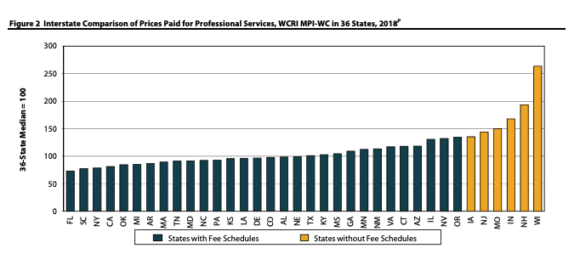The second Workers’ Compensation Research Institute study released this month concludes that medical treatment for injured workers costs more and prices are growing faster in states that don’t have fee schedules.
WCRI reported Thursday that in 30 states without fee schedules, the prices paid in 2018 for professional services — to doctors, chiropractors and physical therapists — were 39 to 171 percent higher than the median in six states with fee schedules.
The study also found that professional services prices grew in states without fee schedules at a 34 percent median rate from 2008 to 2018, compared to 6 percent for fee schedule states.
The study included 36 states that represent 88 percent of the workers’ comp benefits paid in the United States, WCRI said.
WCRI released a similar report on May 16 that showed in states without fee schedules outpatient surgery payments to hospitals were also higher than in states with fee schedules, measured relative to Medicare rates.
The study of professional services prices showed all six of the states without fee schedules — Indiana, Iowa, Missouri, New Hampshire, New Jersey and Wisconsin — paid more than any of the 30 states with fee schedules. Wisconsin was on the very top: Prices were 66 percent higher than the median of the states with fee schedules.
The study says insurers in Wisconsin paid more than three times as much for professional services as insurers in Florida, which had the lowest prices of all the 36 study states. Florida paid 27 percent below the 36-state median while Wisconsin paid 164 percent of the median for professional services.
Not only did prices vary widely among the states; the rate of growth also varied tremendously, WCRI said. From 2008 to 2018, the overall change in prices ranged from a 15 percent reduction in Illinois to a 44 percent increase in Wisconsin.
Growth rates were slowest in fee schedule states. WCRI focused on 22 of the study states that had no major fee schedule changes from 2008 to 2018 and five states without fee schedules. In three of the states without fee schedules — Indiana, Missouri and Wisconsin — prices paid increased from 34 percent to 44 percent during the 11 years. In the 22 fee schedule states examined, the rate of growth range from a 3 percent reduction in Nebraska to a 24 percent increase in Georgia.
Wisconsin stood out in the study as both the state with the highest prices among the 36 states studied but also the largest cumulative increase in prices.
Wisconsin lawmakers are well aware that medical costs in the state are higher than most. Employers and insurers have been lobbying for adoption of a fee schedule for years.
Opponents of legislation introduced at the statehouse point out that the Wisconsin workers’ compensation system is enviable in many respects.
Mark Grapentine, senior vice president of government relations for the Wisconsin Medical Society, told state lawmakers during a committee hearing last year that Wisconsin’s system “is often referred to as a national model, in no small part due to injured workers’ ready access to high quality health care.” He noted a WCRI research report that showed injured workers’ in Wisconsin spent three weeks less time on temporary disability than workers in the other study states.
Grapentine’s memo to also noted WCRI studies that show a far smaller portion of Wisconsin injured workers reported problems getting care than in other states, employers paid for defense attorneys in a smaller percentage of claims and total claims costs were lower in Wisconsin than the median of study states.
“Of fundamental importance: health care requires fewer visits per claim and fewer services per visit than in most other states – that’s one of the reasons why our costs overall are so beneficial for employers,” Grapentine said in an email.
Wisconsin Senate Bill 665, introduced in 2017 by the Committee on Labor and Regulatory Reform to impose a fee schedule and make other changes to the workers’ comp system, never passed the state Senate.
Was this article valuable?
Here are more articles you may enjoy.


 Tesla, EEOC Plan Talks to Settle Factory Racism Suit
Tesla, EEOC Plan Talks to Settle Factory Racism Suit  California Governor Seeks $200M to Replace EV Tax Credits Cut by Trump
California Governor Seeks $200M to Replace EV Tax Credits Cut by Trump  First Brands Judge Approves Examiner to Probe Fraud Allegations
First Brands Judge Approves Examiner to Probe Fraud Allegations  Munich Re: Insured Losses From Wildfires, Storms and Floods Hit Record High
Munich Re: Insured Losses From Wildfires, Storms and Floods Hit Record High 